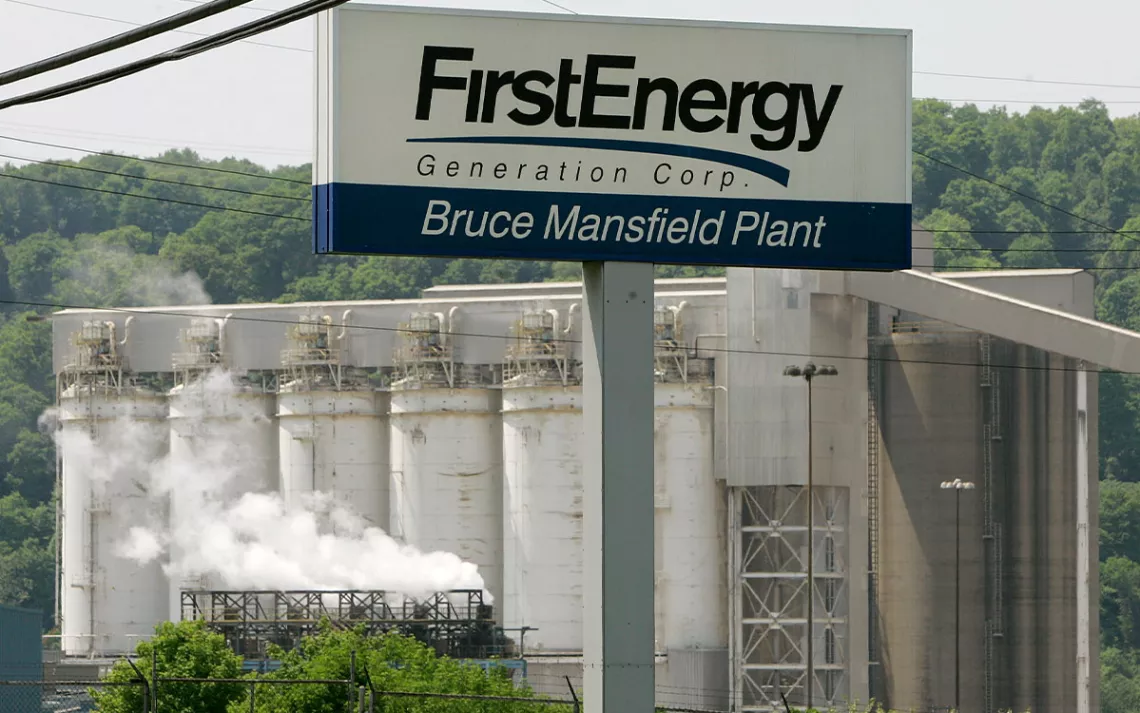The Nation’s Biggest Utilities Are Lagging on Fossil Fuel Phaseout
The Sierra Club’s “Dirty Truth” report found that most aren’t taking action on their climate goals

Photo byKeith Srakocic/AP
Ohio is ground zero for one of the most far-reaching corruption schemes in the energy industry. For years, Akron-based utility giant FirstEnergy’s coal and nuclear plants had been failing, and company executives wanted a state bailout. So in 2019, they developed a scheme to float some $60 million in campaign donations to state officials in exchange for passing House Bill 6. The now-infamous bill gutted state renewable energy standards and granted up to $1 billion in lucrative subsidies for FirstEnergy’s struggling operations, leaving ratepayers to foot the bill.
Though Ohio reached a settlement with FirstEnergy this summer, the state is still grappling with the impacts of the scandal, which sent utility bills skyrocketing. Meanwhile, FirstEnergy continues to promote itself as climate-conscious, advertising a goal of net-zero emissions by 2050 and offering rebates for transitioning to electric vehicles—even as its West Virginia–based utility, Mon Power, has zero plans to shut down 3,200 MW of coal plants.
“There is a fundamental mistrust there,” said Neil Waggoner, Midwest Beyond Coal campaign manager. “We've seen corruption, not just in Ohio, but in Illinois, in Florida.”
FirstEnergy is just one of the 50 parent companies and 75 utilities tracked in the fourth annual edition of the Sierra Club's The Dirty Truth report, a yearly analysis that investigates whether the nation’s biggest utilities are backing up their goals for net-zero emissions with concrete plans to phase out fossil fuels. The report tracks utilities’ progress on three key milestones: retiring coal by 2030, not building new gas plants by 2035, and expanding renewable energy by 2035.
This year’s report gave these utilities a collective D on their clean energy progress. Mon Power and FirstEnergy both scored an F, earning zero out of 100 possible points, and just six companies earned an A. Altogether, the companies included in the report are on track to replace only half of their current fossil fuel generation with clean energy by 2035—even as the Biden administration has committed to reaching 100 percent renewable energy by 2035.
While this year’s Dirty Truth scores have improved since the report’s initial release in 2021, Cara Fogler, a lead analyst for the report, said utilities should be scoring much higher under the intentionally “generous” rating system. “We wanted to give utilities the opportunity to progress and to do better year after year,” she said, “and that progression has just been too slow. So while we're seeing some more move into the A category, we really should be seeing a huge increase into the A category that we're not seeing.”
A major reason for this expected progress is the Inflation Reduction Act, a $370 billion climate policy package passed in 2022. The act allocated a major slice of these funds to help public power utilities bring down the cost of clean energy, from grants and tax credits to direct funding for renewables. Now, two years in, these IRA dollars are seeping into the climate strategy of some utilities—and being ignored by others.
“We saw cases from last year of utilities saying, ‘We're actually going to give money back to our customers because we're saving so much money from the IRA,’” said Noah Ver Beek, a lead analyst for The Dirty Truth. Florida Power and Light, which received a B, announced a plan in 2022 to refund customers nearly $400 million due to savings from the IRA.
FPL remains an outlier. The Sierra Club reported last year that nearly a third of the nation’s major utilities hadn’t announced any specific plans to take advantage of IRA funding. According to Ver Beek, failing to incorporate IRA dollars in utility-scale planning isn’t just a climate issue— it’s actively costing customers. “We want to see more utilities using this money, using these opportunities, and listening to their customers, who, by and large, want more clean energy and less fossil fuels,” he said.
But investing in clean energy buildouts isn’t an all-encompassing solution—just as important as bolstering renewables, Fogler said, is getting off fossil fuels. Duke Energy Florida announced a similar plan to refund customers following the IRA’s passage. Still, DEF’s lack of plans to retire any of its nearly 1,500 MW of coal capacity, as well as its plan to build nearly 1 GW of additional gas by 2035, earned the utility an F.
The United States and six other world leaders pledged this April to shut down coal power plants by the early 2030s, a benchmark analysts say advanced nations must hit in order to keep global warming below 1.5°C. With some utilities still lagging behind on coal retirements, Fogler said that as a utility, “you really can't be a high performer if you could not at least hit that benchmark.”
The Dirty Truth still revealed promising policy from the top-scoring utilities. Compared to data from the report’s first edition in 2021, even more of the lower-scoring utilities are beginning to release climate goals, she said, while higher-scorers are paving the way on IRA incentives.
“We're hopeful to push utilities to say, ‘You're close; you're a leader here. Let's go ahead and take that next step in the planning process, using the incentives from the IRA, and really lean into the clean build to fully replace the coal that you’re retiring,’” Fogler said.
 The Magazine of The Sierra Club
The Magazine of The Sierra Club



